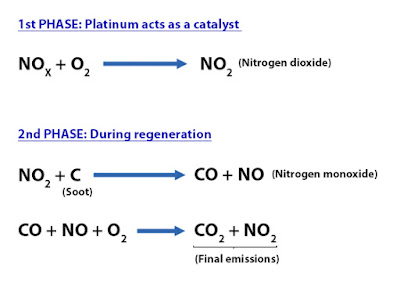The job of the particulate filter is to retain the ash particles that are generated in the diesel engine during the combustion process, thus preventing the ash particles being emitted to the atmosphere.
To prevent the filter from becoming saturated these particles are periodically eliminated by means of a process called regeneration, which consists of combusting the ash particles into other less harmful particles by raising the temperature through catalytic processes.
There are two types of diesel particulate filters:
- Particulate filter with catalytic additive
- Particulate filter with catalytic recovery
The first requires a cerine (eolys) based additive fluid which facilitates the regeneration process and the second type of particulate filter does not require an additive because it burns the particles in a dry state.
Particulate filter with catalytic recovery
The current trend is to fit these types of filters because they are easier to produce and do not require maintenance because they do not have the additive system.
For the ECU to be able to calculate the degree of filter saturation it needs to be able assess the soot content of the filter. The particulate filter has two pressure ports, one before the filter and one after the filter. If there is a significant pressure difference between the two pressure ports then the system will start the regeneration process to remove the ash particles.
Filter regeneration can be carried out in three different ways:
Active regeneration: When the vehicle is constantly driven over short distances the particulate filter will not reach the necessary temperature for passive regeneration. Under these circumstances the engine control unit (ECU) will implement a series of actions to increase the temperature of the particulate filter. In such circumstances the ECU recalculates the fuelling requirements of the engine and reduces the main injection cycle and activates a process called post-injection: this is where the fuel is injected on the exhaust stroke. The main purpose of post-injection is to raise the temperature of the exhaust gases with the ultimate aim of increasing the particulate filter temperature to 600-650ºC. This process takes around ten minutes.
Emergency regeneration: When normal and active regeneration has failed to clean the diesel particulate filter the particulate/emission warning light will be illuminated on the instrument panel. This warns the driver to either consult a suitable workshop or to drive the vehicle at a particular speed and rpm to increase the temperature of the exhaust gases and the particulate filter. Driving the vehicle under these conditions should regenerate the filter and burn away ash deposits, if this is successful the system switches off the warning light from the instrument display.
In principle diesel particulate filters should have an efficient useful working life as long as that of the vehicle they are fitted on. There are a number of factors that compromise the life of a diesel particulate filter, for example, using unsuitable engine oils with a high ash content, this ash causes irreversible degradation of the filter by depositing ash on the surface of the monolith. Oil ash eventually restricts the flow of the exhaust gases and blocks the filter, the only cure is a new diesel particulate filter.




No comments:
Post a Comment